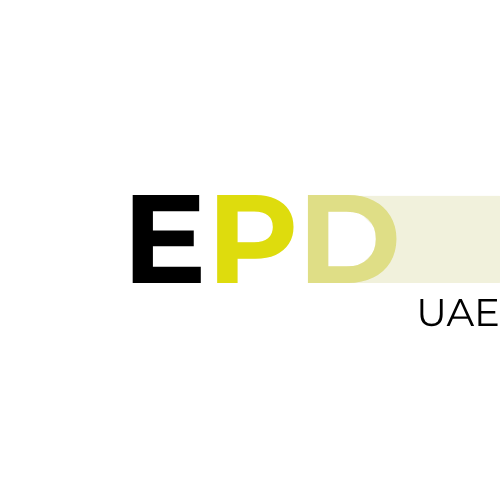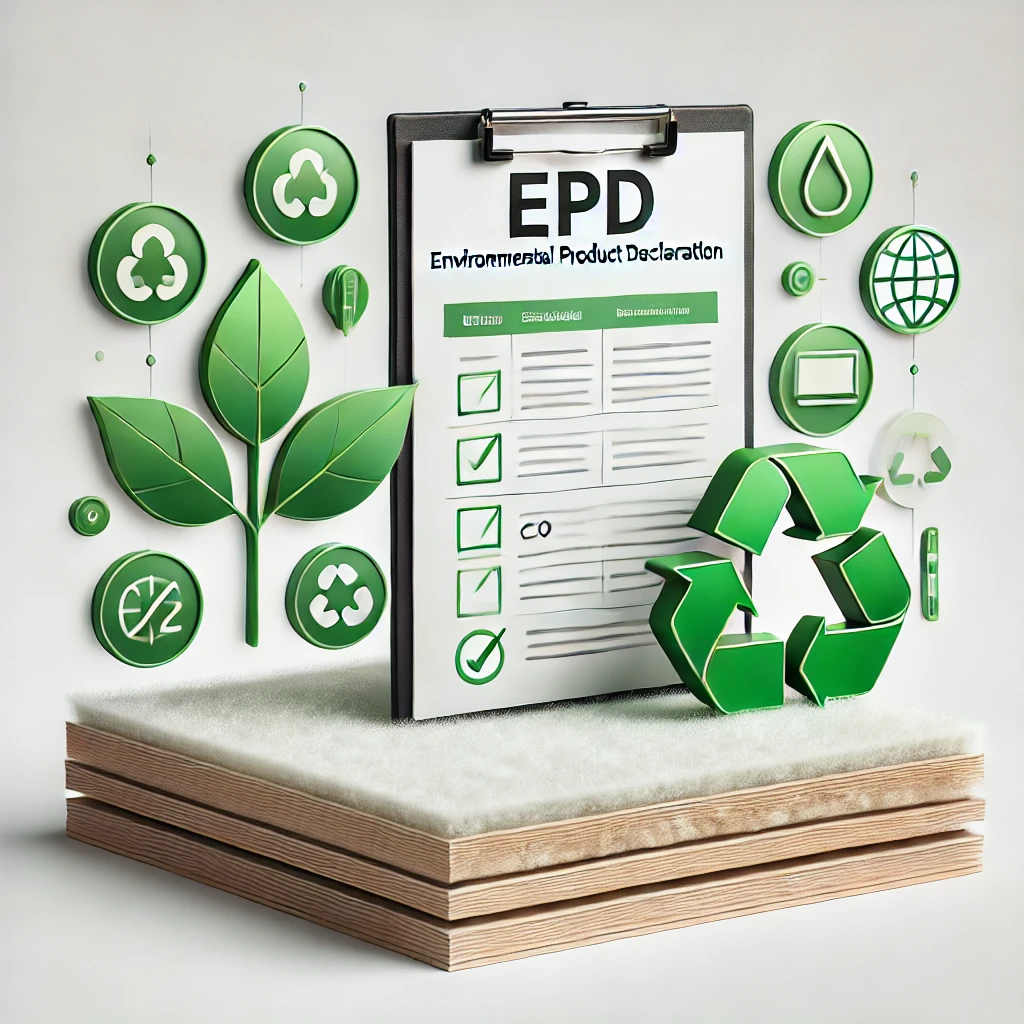We provide EPD consultancy to document your product’s environmental impact and support your sustainability goals.
What is an Environmental Product Declaration (EPD), and why is it important?
An Environmental Product Declaration (EPD) is a standardized, third-party verified document that provides transparent and comparable information about the environmental impact of a product throughout its life cycle. Based on international standards such as ISO 14025 and EN 15804, an EPD includes data on resource use, energy consumption, emissions, and waste generation from raw material extraction to end-of-life disposal.
EPDs are important because they promote sustainability by allowing architects, engineers, and developers to make informed decisions when selecting materials. They also help manufacturers demonstrate their commitment to environmental responsibility and improve their products’ marketability. In green building certification systems like LEED, BREEAM, and WELL, EPDs contribute to earning credits, supporting a project’s overall sustainability goals. Ultimately, EPDs encourage transparency, foster environmental awareness, and support the transition to a more sustainable and circular economy.
What are the main steps involved in preparing an EPD?
Preparing an Environmental Product Declaration (EPD) involves several key steps to ensure transparency, accuracy, and compliance with international standards.
Define the Product and Scope: Identify the product and its intended use, then set the system boundaries (cradle-to-gate, cradle-to-grave, etc.).
Select a Relevant PCR: A Product Category Rule (PCR) provides specific guidelines for the product type and ensures consistency.
Conduct a Life Cycle Assessment (LCA): Perform a detailed LCA based on ISO 14040/44 standards using data on raw materials, energy use, transportation, production, and disposal.
Prepare the EPD Document: Compile the LCA results and additional information into the EPD format, following ISO 14025 and the selected PCR.
Third-Party Verification: Submit the EPD for independent verification by an approved verifier to ensure accuracy and reliability.
Publication: Register and publish the verified EPD through a recognized program operator, making it publicly accessible for transparency and use in green certifications.
How does EPD consultancy help manufacturers achieve sustainability goals?
EPD consultancy helps manufacturers achieve sustainability goals by guiding them through the complex process of developing Environmental Product Declarations (EPDs). Consultants provide expertise in selecting the correct Product Category Rule (PCR), collecting accurate life cycle data, and conducting Life Cycle Assessments (LCAs) in line with international standards like ISO 14025 and EN 15804.
By identifying environmental hotspots in the product life cycle, consultants help manufacturers improve resource efficiency, reduce emissions, and optimize production processes. This data-driven approach not only enhances product sustainability but also supports eco-design strategies and continuous improvement.
EPD consultants also assist in third-party verification and registration, ensuring the EPD is credible and recognized globally. Having verified EPDs improves brand image, meets regulatory and green building requirements, and opens access to environmentally conscious markets. Ultimately, EPD consultancy empowers manufacturers to align their operations with circular economy principles and contribute meaningfully to global sustainability efforts.
What standards and guidelines are followed in EPD development?
EPD development follows internationally recognized standards and guidelines to ensure consistency, transparency, and credibility. The primary standard is ISO 14025, which defines the principles and procedures for Type III environmental declarations. It requires third-party verification and supports the use of Product Category Rules (PCRs).
Another key standard is EN 15804, commonly used in the construction sector. It provides core rules for EPDs of building products and ensures uniformity in how environmental data is reported, enabling fair comparison between similar products.
The ISO 14040 and ISO 14044 standards are also essential, as they guide the Life Cycle Assessment (LCA) process, which is the foundation of any EPD. These standards define how to assess environmental impacts across a product’s life cycle.
Additionally, Product Category Rules (PCRs) provide product-specific instructions for conducting LCAs and compiling EPDs. Together, these standards ensure that EPDs are scientifically robust, transparent, and comparable across markets.
What is a Product Category Rule (PCR), and why is it essential in EPD creation?
A Product Category Rule (PCR) is a set of specific guidelines that define how to conduct a Life Cycle Assessment (LCA) and report environmental data for a particular product category. It ensures that all Environmental Product Declarations (EPDs) within the same category are prepared using consistent methods and assumptions, enabling fair and transparent comparison between similar products.
PCRs specify the functional unit, system boundaries, data quality requirements, and environmental impact categories to be considered in the LCA. They are developed according to ISO 14025 and often align with sector-specific standards like EN 15804 for construction products.
PCRs are essential in EPD creation because they bring uniformity and credibility to the process. Without a PCR, different manufacturers might report environmental impacts using inconsistent methods, leading to unreliable comparisons. By following a PCR, companies ensure their EPDs are comparable, trustworthy, and suitable for use in green building certifications and public sustainability reporting.
What kind of data is required for an EPD?
An Environmental Product Declaration (EPD) requires detailed and accurate data to evaluate the environmental impacts of a product throughout its life cycle. The core data comes from a Life Cycle Assessment (LCA) and includes both primary data (specific to the manufacturer) and secondary data (from databases).
Key data categories include:
- Raw Material Extraction: Types, quantities, and sources of raw materials used.
- Energy Use: Electricity and fuel consumption during production.
- Water Consumption: Amount of water used in processes.
- Emissions: Air, water, and soil emissions from manufacturing processes.
- Waste Generation: Types and quantities of waste and how they are managed.
- Transportation: Distances and modes used to transport materials and products.
- Packaging: Materials and weights used for packaging.
- Product Use and End-of-Life: If relevant, data on use phase impacts, recyclability, and disposal methods.
Collecting this data ensures the EPD accurately reflects the product’s environmental profile.
How is a Life Cycle Assessment (LCA) related to EPDs?
A Life Cycle Assessment (LCA) is the foundation of an Environmental Product Declaration (EPD). It systematically evaluates the environmental impacts of a product across its entire life cycle—from raw material extraction to manufacturing, use, and end-of-life disposal.
In EPD development, the LCA provides the quantitative data required to assess environmental indicators such as global warming potential, resource depletion, energy use, and waste generation. This data is collected and calculated according to international standards like ISO 14040 and ISO 14044, ensuring a consistent and scientific approach.
The results of the LCA are then compiled into the EPD document, following the rules set by a relevant Product Category Rule (PCR) and the ISO 14025 standard. Without a properly conducted LCA, an EPD cannot be created. Therefore, the accuracy and quality of the EPD depend directly on the reliability of the underlying LCA, making it an essential step in the EPD process.
What are the typical environmental impact categories included in an EPD?
An Environmental Product Declaration (EPD) includes several standardized environmental impact categories to provide a comprehensive view of a product’s effects on the environment. These categories are typically based on results from a Life Cycle Assessment (LCA) and follow international standards like EN 15804 and ISO 14025.
Common impact categories include:
- Global Warming Potential (GWP) – Measures greenhouse gas emissions contributing to climate change, expressed in CO₂ equivalents.
- Ozone Depletion Potential (ODP) – Assesses emissions that degrade the ozone layer.
- Acidification Potential – Evaluates emissions that cause acid rain, affecting soil and water.
- Eutrophication Potential – Measures nutrient release that can lead to water pollution and algae blooms.
- Photochemical Ozone Creation Potential (POCP) – Refers to smog formation caused by volatile organic compounds.
- Resource Depletion – Includes depletion of fossil fuels, minerals, and other natural resources.
These categories help stakeholders understand and compare environmental performance across products.
How long is an EPD valid, and what happens when it expires?
An Environmental Product Declaration (EPD) is typically valid for five years from the date of publication. This timeframe ensures that the information remains current and reflects any significant changes in the product’s design, production process, or raw materials.
When an EPD expires, the manufacturer must review and update the Life Cycle Assessment (LCA) and ensure it aligns with the latest standards and Product Category Rules (PCR). If there have been no significant changes, the EPD can be renewed with updated verification. However, if major modifications have occurred, a new LCA and third-party verification are required before reissuing the EPD.
Expired EPDs are usually removed from public databases or clearly marked as outdated, meaning they can no longer be used for green building credits or certifications like LEED, BREEAM, or WELL. Keeping an EPD up to date demonstrates a manufacturer’s commitment to transparency and continuous improvement in sustainability.
What tools or software are commonly used in EPD generation?
Common tools and software used in EPD generation are designed to perform Life Cycle Assessments (LCA) and ensure compliance with standards like ISO 14025, ISO 14040/44, and EN 15804.
SimaPro: A leading LCA tool used by professionals for detailed environmental impact analysis. It offers access to databases like ecoinvent and supports complex product modeling.
GaBi Software: Known for its robust datasets and industry-specific tools, GaBi is widely used by manufacturers for LCA and EPD creation.
OpenLCA: An open-source LCA software that is cost-effective and flexible. It supports multiple impact assessment methods and is suitable for EPD development.
One Click LCA: A cloud-based tool focused on construction and building materials. It allows fast EPD generation with built-in templates and easy database access.
EPD Generator Tools: Some program operators offer their own tools to streamline EPD submission and verification.
These tools help ensure accuracy, transparency, and efficiency in the EPD process.


